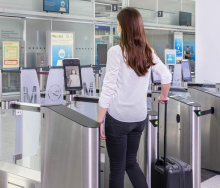From November, travellers to the EU originating from non-EU countries, will have to go through the new digital Entry-Exit System (EES). However, there are concerns that the implementation of the system will mean long queues and delays at entry points.
Although the EES is meant to make cross-border movement more efficient, many industries and governments fear that the initial registration of biometric data by all individuals crossing borders will create long queues and cause travel delays at their ports of entry.
In the UK, Kent Council Leaders have called on the UK Government to act to avoid disruption to cross-channel travel when the EES becomes effective.
According to Schengen News, the registration process will be completed on computer kiosks placed at border crossing points. These kiosks will register foreign travellers by scanning their fingerprints and passport information and taking pictures of their faces for the EES database.
To avoid delays during the initial registration process, the UK Department of Transport has invested £3,5 million (R82 million) in equipping its main access points to the EU – including the Port of Dover, Eurostar and Eurotunnel – with registration kiosks to reduce the risk of queuing and disruption, reports Travel Weekly UK.
However, the Kent Council has also pointed out that there have been no updates on the EES pre-registration app, which would assist the initial registration process and reduce congestion at EU borders.
France's Normandy Port is also expecting long queues and is preparing tablets to collect registration data, alongside its kiosks. Additionally, staff members will pre-register people driving across the border, while they wait in queues, reports Schengen News.
While some European countries, such as Lithuania, have reported that they are ready for EES to go live, others, such as Malta, are still lagging and are receiving assistance from the European Commission to complete preparations.














